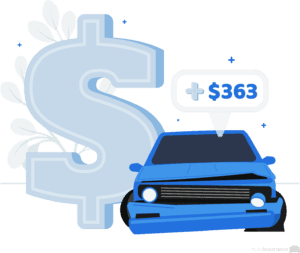
What Is Collision Insurance? A Complete Guide
Fixing your car after an accident is imperative to get you back on the road.
Get quotes from providers in your area

Collision insurance is coverage on your insurance policy that will pay to repair your car after an accident. Collision coverage isn’t required, but it is highly recommended so that you have the means to fix your car if it gets damaged in a crash. Let’s dig deeper into what collision coverage is.

What Is Collision Insurance?
Collision coverage is protection for your vehicle that pays to repair it after a crash. Collision insurance typically applies to at-fault accidents but also may provide coverage to your automobile if another driver hits you and they don’t have insurance.
Collision coverage is optional on an auto insurance policy unless you bought a car with leasing or financing. A loan or lease often requires collision coverage with certain deductible amounts. Learn more about car loans.
When you combine collision coverage with comprehensive coverage, you have full coverage on your car. When you make a collision claim, you pay the deductible for your portion of the claim, and the insurance company pays the rest. You usuall
y choose the deductible when you start the insurance policy.
What Does Collision Insurance Cover?
Collision insurance covers your car from damages after a collision of some sort, whether you need to repair or replace your vehicle. Generally, you don’t need to rely on collision coverage if the other party is at fault, but there are some instances where collision coverage applies.
One example is when an uninsured motorist hits you and you don’t have uninsured motorist coverage. In this situation, collision coverage helps pay the claim, minus the deductible, up to the fair market value of the vehicle.
What Doesn’t Collision Coverage Cover?
Collision coverage doesn’t cover every type of loss. It doesn’t cover the liability of you hitting another car, person, or piece of property (that’s liability insurance in the form of property damage coverage). It also won’t cover losses to your vehicle that occur from things like theft, vandalism, and hail. A separate deductible may apply for these types of incidents if you have comprehensive coverage.
NOTE
Getting both comprehensive and collision coverage means you have “full coverage.”
How Collision Coverage Works
The way collision coverage works is simple: If you’re in an accident, you will pay your deductible, and then the insurance company will pay for the rest of the repairs up to the policy limits. The policy limit for collision coverage is the fair market value of the car. Those who have older cars sometimes drop collision coverage because they feel it isn’t worth the cost of insurance to protect a car that will be totaled for just a few thousand dollars of repairs.
Anyone who wants to make sure their vehicle is covered in an accident should get collision coverage. It isn’t required by state laws, since those only require liability coverage, but is a good idea to make sure your car can be fixed after something happens.
What Is a Collision Deductible?
When you elect to have collision coverage on your car, the insurance agent will ask you what deductible you want. The average deductible is $500, but you can choose a higher or lower deductible depending on your financial situation.
Higher deductibles mean lower insurance premiums, and vice versa. When there is a covered claim, the deductible is your portion of the claim, the amount you will pay. The insurance company won’t pay anything until you meet the deductible.
Choosing a Collision Deductible
It can be difficult to choose the right deductible for your policy. It’s natural to want to save as much money as possible and choose a higher deductible, such as $2,000, but then you’ll be responsible for that much in a claim.
Think ahead about a claim, making sure you have the funds to meet your deductible. If you can’t meet the deductible, you might have damages to your car that you cannot fix. This would be frustrating and certainly would make for a bad claims experience.
TIP
Consider increasing your deductible to lower your cost of insurance.

The Cost of Collision Insurance
Collision insurance is not sold independently; it is an add-on to the liability coverage of an insurance policy. However, you can expect collision coverage to be a major part of the policy.
Collision coverage can cost anywhere from $200 to $500 per policy period. The average collision insurance cost is $377 added to your liability policy for the term, based on the most recent data from 2021; the most recent data from the NAIC).2 As of our 2025 analysis, the average cost of full coverage is $2,399 annually, which includes comprehensive coverage.
How to Get Collision Insurance
Getting collision insurance is as simple as asking for it when you buy a policy. You can even add it to an existing policy; the rate will be prorated for the difference. When shopping for collision insurance coverage, ask the agent to run scenarios with different deductibles so that you can find the sweet spot with savings versus potential out-of-pocket claim costs.
Collision vs. Comprehensive Coverage
Both collision and comprehensive insurance are elected coverages. While collision coverage pays for damages from actual collisions with other cars, people, or objects, comprehensive coverage protects you from incidents that happen from non-collision events. These incidents include theft, vandalism, tree branches falling on your car, floods, and hail.
Collision vs. Liability Coverage
Collision coverage is added to the liability portion of an auto insurance policy. The liability portion covers damages to third parties. If you hit another car, liability pays for the damages to the car and the injuries to the people inside. Collision coverage pays to repair your vehicle.
Recap
Collision insurance is an elected policy coverage that pays for your car repairs after an accident. Without it, you may be covered to pay for repairs of another party’s car that you hit, but your car would be left unrepaired. Collision coverage has a deductible associated with it; this is your portion of the claim, which you must pay prior to the insurance company paying for damages. Get a full coverage quote that includes collision insurance when shopping for cheap insurance.
Citations
What is Collision Insurance?. Allstate. (n.d.).
https://www.allstate.com/resources/car-insurance/what-is-collision-insurance2021/2022 Auto Insurance Database Report. National Association of Insurance Commissioners (NAIC). (2025, January).
https://content.naic.org/sites/default/files/publication-aut-pb-auto-insurance-database.pdf

